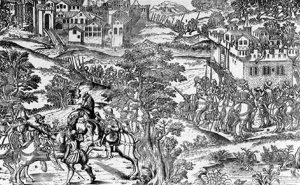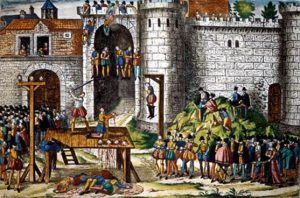The beginnings of the Conspiracy
 Amboise conspiracy (March, 15 1560) © S.H.P.F.
Amboise conspiracy (March, 15 1560) © S.H.P.F.
After Henri II’s death in 1559, Catherine de Medici became regent for her son, king François II. It was she and the Guise family who effectively controlled the country : the duke of Guise was lieutenant general of the realm. After the execution of Anne de Bourg, counsellor to the parliament of Paris, Protestants felt threatened.
For that reason, some members of the Reformation movement tried to seize hold of the king and shield him from the influence of the Guise family.
The Queen of England, Elizabeth I, head of the Anglican Church, sent a financial contribution towards the conspiracy.
As Antoine de Bourbon refused to lead the conspiracy, Louis de Bourbon, prince of Condé was considered as a possible choice. Calvin and most of the Reformed Churches refused to have anything to do with such preparations.
The plot, badly organized, failed
 Suppression at Amboise (1559) © B.P.U. Genève
Suppression at Amboise (1559) © B.P.U. Genève
The main conspirator, La Renaudie, a minor lord from the Périgord, gathered a troop of about 200 men and, approaching via the Loire valley, besieged Amboise, where the king was holding court. But someone found out about the plot, the Guise family managed to capture the conspirators and from 17th March onwards, there were severe measures of repression.
Merciless repression
La Renaudie was killed and his body was drawn and quartered. The other leading members of the conspiracy were executed in Amboise – in presence of the court and of several men of note who were especially invited to the execution.
The prince of Condé declined having had any part in the conspiracy.
This act of repression caused Protestants to rise in revolt in many places throughout France – they seized Catholic churches and held Protestant services in them.